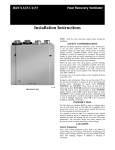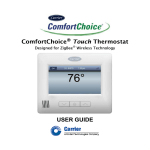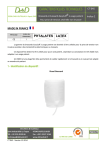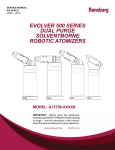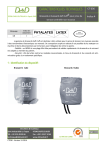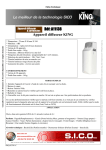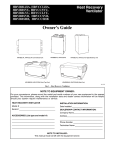Download RPA-2 Powder Applicator (Serv. Man. LN-9271-12.2)
Transcript
SERVICE MANUAL LN-9271-12.2 April 2013 Supersedes LN-9271-12.1 RPA-2 MODEL: A12950-XXX IMPORTANT: Before using this equipment, carefully read SAFETY PRECAUTIONS, starting on page 1, and all instructions in this manual. Keep this Service Manual for future reference. Service Manual Price: $50.00 (U.S.) LN-9271-12.2 RPA-2 POWDER APPLICATOR - Contents CONTENTS SAFETY: PAGE 1-6 SAFETY PRECAUTIONS ......................................................................................................... 1 HAZARDS / SAFEGUARDS................................................................................................... 2-6 INTRODUCTION: 7-11 GENERAL DESCRIPTION........................................................................................................ 7 POWDER APPLICATOR MAIN COMPONENTS ...................................................................... 8 TOOLS REQUIRED .................................................................................................................. 9 HIGH VOLTAGE GENERATION/ROUND NOZZLE DESCRIPTION ....................................... 10 SPECIFICATIONS/CENTER OF GRAVITY ............................................................................ 11 INSTALLATION: 12-13 CONNECTION PROCEDURE ................................................................................................ 12 FUNCTION CHECK AND SCHEMATIC .................................................................................. 13 OPERATION: 14-15 GENERAL OPERATION/START-UP ................................................................................. 14-15 MAINTENANCE: 16-27 TROUBLESHOOTING GUIDE ........................................................................................... 16-17 INSPECTING AND CLEANING.......................................................................................... 17-18 APPLICATOR DIS-ASSEMBLY ......................................................................................... 18-24 HIGH VOLTAGE CONTACT WIRE REPAIR ........................................................................... 25 APPLICATOR ASSEMBLY ..................................................................................................... 26 DEFECTIVE PARTS RECOGNITION ..................................................................................... 27 PARTS: 28-42 APPLICATOR PARTS DRAWING ..................................................................................... 28-30 PARTS LIST AND DRAWINGS.......................................................................................... 31-37 SHAPE AIR ASSEMBLY AND PARTS LIST ...................................................................... 37-38 ELECTRODE ASSEMBLY AND PARTS LIST ................................................................... 39-40 SPARE PARTS .................................................................................................................. 41-42 WARRANTY POLICIES: 43 LIMITED WARRANTY............................................................................................................. 43 LN-9271-12.2 RPA-2 POWDER APPLICATOR– Safety SAFETY SAFETY PRECAUTIONS Before operating, maintaining or servicing any Ransburg electrostatic coating system, read and understand all of the technical and safety literature for your Ransburg products. This manual contains information that is important for you to know and understand. This information relates to USER SAFETY and PREVENTING EQUIPMENT PROBLEMS. To help you recognize this information, we use the following symbols. Please pay particular attention to these sections. A WARNING! states information to alert you to a situation that might cause serious injury if instructions are not followed. A CAUTION! states information that tells how to prevent damage to equipment or how to avoid a situation that might cause minor injury. A NOTE is information relevant to the procedure in progress. While this manual lists standard specifications and service procedures, some minor deviations may be found between this literature and your equipment. Differences in local codes and plant requirements, material delivery requirements, etc., make such variations inevitable. Compare this manual with your system installation drawings and appropriate Ransburg equipment manuals to reconcile such differences. ! WARNING The user MUST read and be familiar with the Safety Section in this manual and the Ransburg safety literature therein identified. This manual MUST be read and thor- oughly understood by ALL personnel who operate, clean or maintain this equipment! Special care should be taken to ensure that the WARNINGS and safety requirements for operating and servicing the equipment are followed. The user should be aware of and adhere to ALL local building and fire codes and ordinances as well as NFPA-33 SAFETY STANDARD, LATEST EDITION, prior to installing, operating, and/or servicing this equipment. ! WARNING The hazards shown on the following pages may occur during the normal use of this equipment. Please read the hazard chart beginning on page 2. Careful study and continued use of this manual will provide a better understanding of the equipment and process, resulting in more efficient operation, longer trouble-free service and faster, easier troubleshooting. If you do not have the manuals and safety literature for your Ransburg system, contact your local Ransburg representative or Ransburg. 1 LN-9271-12.2 RPA-2 POWDER APPLICATOR - Safety AREA HAZARD SAFEGUARDS Tells where hazards may occur. Tells what the hazard is. Tells how to avoid the hazard. Spray Area Fire Hazard Fire extinguishing equipment must be present in the spray area and tested periodically. Improper or inadequate operation and maintenance proce- Spray areas must be kept clean to prevent the accumulation of combustible residues. dures will cause a fire hazard. Protection against inadvertent Smoking must never be allowed in the spray area. arcing that is capable of causing fire or explosion is lost if any safety interlocks are disabled during operation. Frequent Power Supply or Controller shutdown indicates a problem in the system requiring correction. The high voltage supplied to the atomizer must be turned off prior to cleaning, flushing or maintenance. When using solvents for cleaning: • Those used for equipment flushing should have flash points equal to or higher than those of the coating material. • Those used for general cleaning must have flash points above 100°F (37.8°C). Spray booth ventilation must be kept at the rates required by NFPA-33, OSHA, country, and local codes. In addition, ventilation must be maintained during cleaning operations using flammable or combustible solvents. Electrostatic arcing must be prevented. Safe sparking distance must be maintained between the parts being coated and the applicator. A distance of 1 inch for every 10KV of output voltage is required at all times. Test only in areas free of combustible material. Testing may require high voltage to be on, but only as instructed. Non-factory replacement parts or unauthorized equipment modifications may cause fire or injury. If used, the key switch bypass is intended for use only during setup operations. Production should never be done with safety interlocks disabled. Never use equipment intended for use in waterborne installations to spray solvent based materials. The paint process and equipment should be set up and operated in accordance with NFPA-33, NEC, OSHA, local, country, and European Health and Safety Norms. LN-9271-12.2 2 RPA-2 POWDER APPLICATOR– Safety AREA HAZARD SAFEGUARDS Tells where hazards may occur. Tells what the hazard is. Tells how to avoid the hazard. Spray Area Explosion Hazard Electrostatic arcing must be prevented. Safe Improper or inadequate opera- sparking distance must be maintained between the tion and maintenance proce- parts being coated and the applicator. A distance dures will cause a fire hazard. of 1 inch for every 10KV of output voltage is reProtection against inadvertent quired at all times. arcing that is capable of causing fire or explosion is lost if any Unless specifically approved for use in hazardous safety interlocks are disabled locations, all electrical equipment must be located outside Class I or II, Division 1 or 2 hazardous during operation. areas, in accordance with NFPA-33. Frequent Power Supply or Controller shutdown indicates a Test only in areas free of flammable or combusproblem in the system requiring tible materials. correction. The current overload sensitivity (if equipped) MUST be set as described in the corresponding section of the equipment manual. Protection against inadvertent arcing that is capable of causing fire or explosion is lost if the current overload sensitivity is not properly set. Frequent power supply shutdown indicates a problem in the system which requires correction. Always turn the control panel power off prior to flushing, cleaning, or working on spray system equipment. Before turning high voltage on, make sure no objects are within the safe sparking distance. Ensure that the control panel is interlocked with the ventilation system and conveyor in accordance with NFPA-33, EN 50176. Have fire extinguishing equipment readily available and tested periodically. General Use and Maintenance Improper operation or mainte- Personnel must be given training in accordance nance may create a hazard. with the requirements of NFPA-33, EN 60079-0. Personnel must be properly Instructions and safety precautions must be read trained in the use of this equip- and understood prior to using this equipment. ment. Comply with appropriate local, state, and national codes governing ventilation, fire protection, operation maintenance, and housekeeping. Reference OSHA, NFPA-33, EN Norms and your insurance company requirements. 3 LN-9271-12.2 RPA-2 POWDER APPLICATOR - Safety AREA HAZARD SAFEGUARDS Tells where hazards may occur. Tells what the hazard is. Tells how to avoid the hazard. Spray Area / High Electrical Discharge Voltage Equipment There is a high voltage device Parts being sprayed and operators in the spray area must be properly grounded. that can induce an electrical charge on ungrounded objects Parts being sprayed must be supported on conveywhich is capable of igniting coat- ors or hangers that are properly grounded. The ing materials. resistance between the part and earth ground must not exceed 1 meg ohm. (Refer to NFPA-33.) Inadequate grounding will cause a spark hazard. A spark can Operators must be grounded. Rubber soled insuignite many coating materials lating shoes should not be worn. Grounding straps and cause a fire or explosion. on wrists or legs may be used to assure adequate ground contact. Operators must not be wearing or carrying any ungrounded metal objects. When using an electrostatic handgun, operators must assure contact with the handle of the applicator via conductive gloves or gloves with the palm section cut out. NOTE: REFER TO NFPA-33 OR SPECIFIC COUNTRY SAFETY CODES REGARDING PROPER OPERATOR GROUNDING. All electrically conductive objects in the spray area, with the exception of those objects required by the process to be at high voltage, must be grounded. Grounded conductive flooring must be provided in the spray area. Always turn off the power supply prior to flushing, cleaning, or working on spray system equipment. Unless specifically approved for use in hazardous locations, all electrical equipment must be located outside Class I or II, Division 1 or 2 hazardous areas, in accordance with NFPA-33. LN-9271-12.2 4 RPA-2 POWDER APPLICATOR– Safety AREA HAZARD SAFEGUARDS Tells where hazards may occur. Tells what the hazard is. Tells how to avoid the hazard. Electrical Equipment Electrical Discharge High voltage equipment is utilized in the process. Arcing in the vicinity of flammable or combustible materials may occur. Personnel are exposed to high voltage during operation and maintenance. Unless specifically approved for use in hazardous locations, the power supply, control cabinet, and all other electrical equipment must be located outside Class I or II, Division 1 and 2 hazardous areas in accordance with NFPA-33 and EN 50176. Turn the power supply OFF before working on the Protection against inadvertent equipment. arcing that may cause a fire or explosion is lost if safety circuits Test only in areas free of flammable or combustible material. are disabled during operation. Frequent power supply shut- Testing may require high voltage to be on, but only down indicates a problem in the as instructed. system which requires correcProduction should never be done with the safety tion. circuits disabled. An electrical arc can ignite coating materials and cause a fire or Before turning the high voltage on, make sure no objects are within the sparking distance. explosion. Toxic Substances Chemical Hazard Follow the requirements of the Material Safety Certain materials may be harm- Data Sheet supplied by coating material manufacful if inhaled, or if there is con- turer. tact with the skin. Adequate exhaust must be provided to keep the air free of accumulations of toxic materials. Use a mask or respirator whenever there is a chance of inhaling sprayed materials. The mask must be compatible with the material being sprayed and its concentration. Equipment must be as prescribed by an industrial hygienist or safety expert, and be NIOSH approved. 5 LN-9271-12.2 RPA-2 POWDER APPLICATOR - Safety AREA HAZARD SAFEGUARDS Tells where hazards may occur. Tells what the hazard is. Tells how to avoid the hazard. Spray Area Explosion Hazard— Incompatible Materials Halogenated hydrocarbon solvents for example: methylene chloride and 1,1,1,Trichloroethane are not chemically compatible with the aluminum that might be used in many system components. The chemical reaction caused by these solvents reacting with aluminum can become violent and lead to an equipment explosion. LN-9271-12.2 Aluminum is widely used in other spray application equipment - such as material pumps, regulators, triggering valves, etc. Halogenated hydrocarbon solvents must never be used with aluminum equipment during spraying, flushing, or cleaning. Read the label or data sheet for the material you intend to spray. If in doubt as to whether or not a coating or cleaning material is compatible, contact your coating supplier. Any other type of solvent may be used with aluminum equipment. 6 RPA-2 Powder Applicator - Introduction INTRODUCTION GENERAL DESCRIPTION This operating manual contains all important information required for working with the RPA2 Powder Applicator. It will give you references and tips for the optimal use of your new powder coating system. The RPA-2 is intended exclusively for the electrostatic coating with organic powders. Any other use is considered as nonconforming. The manufacturer is not responsible for any damage resulting from this; the risk for this is assumed by the user alone. With an integrated high voltage generator (cascade), the RPA-2 is particularly suitable for the coating of car bodies and parts. The applicator is designed for operation on a freely programmable hollow wrist robot (up to 7 axes). The RPA-2 is installed on the front side of a follow-arm coating robot. An appropriate adapter piece for the corresponding robot type is used for fitting the applicator to the robot. This adapter provides a locating pin for exact positioning of the applicator, as well as the fixture of the applicator cable and hoses. The RPA-2 has a high and constant transfer efficiency. The applicator is quick detachable, therefore fast and easy for maintenance and repair. The wear parts can be easily changed, even with the applicator attached to the robot. 7 LN-9271-12.2 RPA-2 POWDER APPLICATOR - Introduction 7 1 3 2 5 6 4 1– Shaping Air 5- Applicator Ground Cable and Low Voltage Cable 2– Applicator Body 6– Powder Hose Connection 3– High Voltage Cascade (Internal) 7– Nozzle 4—Robot Adapter Figure 1: RPA-2 Powder Applicator LN-9271-12.2 8 RPA-2 Powder Applicator - Introduction Tools Required for Assembly/Dis-Assembly 76772-00 Spanner Wrench Hex Keys Adjustable Wrench 6mm A13001-00 Tool– Powder Inlet Fitting (Included with applicator) 9 3/16 3/32 Flat Blade Screwdriver LN-9271-12.2 RPA-2 POWDER APPLICATOR - Introduction High Voltage Generation Round Jet Nozzle With Air Cleaned Electrode The applicator high voltage control unit supplies a high frequency low-voltage signal to the cascade. This voltage is fed through the applicator cable and the cascade connection. The low-voltage signal is multiplied in the cascade to produce the necessary high voltage (up to 100 kV). The high voltage is fed through a conductive path in the atomizer to the central electrode (see figure 1) The round nozzle shapes and distributes the powder. The powder cloud obtains a bellsimilar spray pattern by the deflector plate and by the dynamic powder/air flow. The powder is charged by means of the central electrode. The high voltage, which is produced by the cascade in the applicator, is connected to the electrode through the black contact ring on the nozzle holder. The round nozzle front face is rinsed with compressed air in order to prevent powder accumulations. The electrode rinsing air is fed into the electrode holder through the small hole in the black contact ring of the nozzle holder. The electrode rinsing air volume is typically maintained at a constant setting of 40-50 SLPM. POWDER EXIT BLACK CONTACT RING FRONT FACE CENTRAL ELECTRODE Round Nozzle (Figure LN-9271-12.2 10 RPA-2 Powder Applicator - Introduction SPECIFICATIONS Environmental Electrical Operating Temperature: Storage and Shipping Temperature: Humidity: 0°C to +55°C -40°C to +85°C 95% Non-Condensing Output Voltage: 100 kV @ Ø µa Maximum Output Current: 240 µa @ 0 kV Polarity: Negative Physical 11 Height: See Figure Width: See Figure Depth: See Figure Weight: 4.2 kg (9.26 lbs.) LN-9271-12.2 RPA-2 POWDER APPLICATOR - Installation INSTALLATION ! WARNING The relevant Safety Standards, as well as the Safety Regulations of the robot manufacturer must be adhered to for the operation of the RPA-2 applicator CONNECTING PROCEDURE 1. Attach the robot adapter to the end of the robot. 2. Lay out the applicator powder hose, electrode rinsing air hose, cascade rinsing air hose, and shaping air hose in such a way that neither kinks or twist can likely form 3. Connect the shaping air (SA) to the proper push-in fitting on the robot plate. Clean pneumatic tubing of any debris. 4. Connect the electrode rinsing air (EA) to the robot plate. Clean pneumatic tubes of any debris. 5. Connect the cascade rinsing air (CA) to the robot plate. 6. Connect the ground cable to “GND” fitting on the robot plate. Do Not Over Tighten 7. Connect the other end of the ground cable to a good known earth ground source after installing the cable thru the robot arm. 8. Connect the low voltage cable to the robot plate Align marks and tighten set screw. (See Picture) 9. Install tubing and cables thru the robot arm. Attach robot plate to robot adapter with (4) 77566-24C screws. (3/16 hex key) LN-9271-12.2 10. Connect the low voltage cable to the control unit. (see the current MicroPak or Evolver MicroPak controller service manuals for wire termination.) Suggested switch setting: SW-3 (1&2 On) SW-7 (1 On) ( 5&6 Off) 11. Powder supply can either be delivered through the dilute phase pump (Venturi) or dense phase pump. A. Dilute phase powder supply hose is connected to the applicator. (Items 51, 52, 53,and 54 are ordered separately for a Venturi Feed application.) “Table A— Upper Powder Tube” in the “Parts Identi fication” section shows optional parts required for the tube connection. Con nect dilute phase powder supply hose (only if available.) B. Dense phase powder supply hose is connected to the multi-color integrator (MCI). The MCI will use dilution air to dilute the dense phase powder. Dilution air requirements are powder dependent. Connect the MCI to the open threaded connection next to the pneumatic tube connections. The multi-color integrator will also have the required powder supply lines and one more pneumatic link used for a pinch valve. Refer to “Function and Operation” information from MCI manufacturer’s documentation. 12. Align the 2 pins on the applicator rear plate with the mating holes of the robot plate. Spin the mounting ring to tighten applicator to the robot plate. 12 RPA-2 POWDER APPLICATOR - Installation 5. Verify the presence of the high voltage field by means of a high voltage probe. Function Check 1. Switch on the high voltage controls. A good setting to start is 20 kV for doing checks 2. Adjust the high voltage at the control unit. 3. Slowly increase the high voltage. The value of the high voltage display should increase slowly. 4. The maximum nominal output current can be monitored on the applicator control unit. 6. Shaping air, electrode rinsing air, cascade rinsing air and dilution air (if available) are adjusted depending on the application (see “Start-Up” in the “Operation” section). 7. If all tests have been completed positively, the applicator is ready for operation. If malfunctions happen, the error cause can be determined by means of the list in the ‘Troubleshooting Guide” in the maintenance section. Alignment Marks Alignment Marks 13 LN-9271-12.2 RPA-2 POWDER APPLICATOR - Operation OPERATION GENERAL OPERATION START—UP There are several variables that need to be considered when using this applicator. Each one influences the operation. They are: Adjusting the Powder Output /Powder Cloud 1. High voltage affects how much the powder is charged. If the kV is set too high, defects will appear. If the kV is set too low, then the powder will not charge and will not stick to the substrate. The powder output depends on the powder type, the powder hose length, the powder hose diameter, and the powder pump. The RPA-2 applicator can be used in connection with Venturi pumps and dense phase pumps like (i.e. powder pressure pump). 2. Shaping air is used to control pattern size. With high amounts of shaping air, the air will propel the powder particles quickly towards the target. This may reduce transfer efficiency. a. Round Spray– Electrode rinsing air provides a cushion of air in front of the deflector and assists in keeping its front face clear. This s usually set at 45-50 SLPM. b. Open Bore Nozzle- set electrode rinsing air 8-10 SLPM. The air helps keep the electrodes clean. 3. Cascade air is used to ventilate the inside of the applicator. The normal setting is between 25 and 50 SLPM. 4. Target distance between the applicator and substrate will influence how big the pattern is. A good starting point is 8-inches. 5. Robot arm speed (TIP speed) is used to influence the rate at which powder is applied. 6. Powder flow rate is the primary influencer of the rate at which powder can be applied. ! WARNING Make sure that all electrostatically conductive parts within 5 meter of the spray booth are grounded! LN-9271-12.2 The operating principle of the injector and the different powder pumps is explained in their corresponding operating manuals. 1. Switch on the power supply. 2. Adjust the powder output. 3. Adjust the shaping air, so that the form of the powder cloud corresponds to the desired size. A good initial setting is 20 SLPM. 4. Adjust the dilution air ( if powder applicable) so that the form of the powder cloud is uniform. A good initial setting is 90 SLPM. Lowest dilution air setting will be above 40 SLPM. 5. Adjust the electrode rinsing air flow, so that the desired form of powder cloud is not impaired. A good initial setting is 50 SPLM. 6. Switch high voltage on the control unit. (See applicable service manual for operation of high voltage controls.) 7. A good initial voltage setting is 60 kV set point for voltage or current control. 8. Trigger kV and Powder OFF. 14 RPA-2 POWDER APPLICATOR - Operation 9. The adjustments for high voltage, electrode rinsing air, shaping air, dilution air (if available), and powder output can be left as they are now that powder is triggered off. 10. If work is interrupted such as lunch time, night, etc.. Switch off the high voltage control unit and disconnect the main compressed air supply. 15 LN-9271-12.2 RPA-2 POWDER APPLICATOR - Maintenance MAINTENANCE TROUBLESHOOTING GUIDE General Problem Possible Cause Solution High voltage display shows no value, although the control unit is switched on and high voltage is being called for. In the applicator: 1. Replace applicator low voltage cable, send in for repair. Check connections for proper contact. During coating, air flows out of the applicator body. 1. O-Ring defective or missing 1. on shaping ring 2. 2. Loose fitting hose 1. Applicator cable defect 2. High voltage cascade defect 3. Wrong MicroPak switch settings 1. Powder hose, applicator, The applicator injector, non-return valve, does not spray powder in spite or throttle on the injector calling for powder clogged flow. 2. Insert sleeve on the injector is worn 2. Replace high voltage cascade, send in for repair. 3. Check MicroPak settings (Refer to current MicroPak service manual. Replace or insert O-ring Check fitting— push in hose 1. Carry out corresponding cleaning. 2. Replace( see the corresponding Operating Manual of the injector). 3. Replace 4. See “Dense Phase Pump” manual. 3. No conveying air: a. Solenoid valve defective 4. Dense phase pump not working Powder applicator 1. Applicator plug, applicator 1. sprays powder, cable, or connection defecbut the powder tive 2. does not adhere 2. High voltage cascade is deon the work fective 3. piece. 3. Plugged electrode LN-9271-12.2 Replace defective part or send in for repair. Send in the applicator for repair or replace high voltage cascade. Pneumatically blow backwards through hollow tube. 16 RPA-2 POWDER APPLICATOR - Maintenance MAINTENANCE TROUBLESHOOTING GUIDE General Problem Possible Cause Applicator sprays 1. High voltage too low powder, high volt2. Work piece not properly age available, but grounded the powder does not adhere on the work piece. INSPECTING AND CLEANING THE APPLICATOR 1. Blow off the atomizer externally with compressed air. 2. If a solvent wipe is required, use VM&P Naphtha for a final wipe to remove any conductive residue. 3. Clean the atomizer only with a damp rag. Never immerse the components into solvents. Solution 1. Increase high voltage on the control unit. 2. Check the grounding/measure 3. Look for loose connections • Plastic on conductive component • Loose fitting hinges • Non-conductive coating present on substrate before spraying. ! WARNING Before cleaning applicator. switch off the control unit. The compressed air used for cleaning must be free of oil, water and other contaminates. ! WARNING Make sure the large diameter threaded ring (applicator body to shaping ring) is always tightened well. If it is fitted loosely, there is a danger that a discharge may occur with the high voltage, which leads inevitably to damaging the plastic components. 4. Remove any impact fusion on deflector without scratching or scoring the soft plastic surface of the deflector. Impact fusion can be removed with a solvent soaked towel. 5. If impact fusion is not removed, it will shorten the life of the parts and cause defects 6. Blow out all powder hoses with high volume/high velocity air purge during cleaning. 17 ! WARNING Be careful with nozzle electrode during cleaning and maintenance— danger of injury! Never bend or pull electrode LN-9271-12.2 RPA-2 POWDER APPLICATOR - Maintenance Cleaning Powder Hose (Venturi Feed) The powder hose has to be cleaned from the residual powder. The cleaning takes place in the following steps: • The deflector plate is no longer round or is worn • The wedge of the electrode holder wear bar is worn down to the electrode holder • Check low voltage cable for cuts, abrasion, and wear. 1. Strip the powder hose from the connection on the Venturi pump. 2. Blow through the hose manually with compressed air to blow loose powder through to the applicator. 3. Fit the powder hose onto the hose connection on the injector. ! WARNING Regular and conscientious maintenance increases the life span of the RPA-2 applicator and provides for a larger continuous coating quality with reduced defects. Weekly Cleaning and Inspection 1. Remove the electrode holder by removing the shaping air ring. Clean on the inside with compressed air and remove possible powder accumulations. 2. Check for wear or damage on parts that contact powder. 3. Follow “Daily Cleaning” steps. 4. The powder supply is to be filled with powder just before resumption of the operation. DISASSEMBLING THE APPLICATOR Before disassembling the applicator, turn off the air supply to shaping air, atomizing air( if available), and rinsing airs. 1. Remove Robot Adapter Covers Monthly Cleaning and Inspection Follow “Daily cleaning” steps. The atomizer wear parts are to be inspected and replaced if: • Uneven powder distribution on deflector as compared to starting • The spray pattern no longer has a regular form LN-9271-12.2 18 RPA-2 POWDER APPLICATOR - Maintenance 2. Remove Robot Adapter by unthreading large diameter retaining ring. 4a. Unscrew the Shaping Air Ring Applicator with Round Nozzle and Electrode Holder Assembly 4b. Remove the Shaping Air Ring 3. Unscrew Round Deflector 4c. Remove the Nozzle With Power Tube 19 LN-9271-12.2 RPA-2 POWDER APPLICATOR - Maintenance 5. Remove rear plugs to view elbows only 6. View of Lower Powder Tube and Ring Ass’y, and O-ring in Correct Orientation. 6a. Lift Lower Powder Tube and Ring Ass’y 5a. Lift Elbow Off Lower Powder Tube and Ring Ass’y 6b. Lower Powder Tube and Ring Ass’y Alignment Pin 5b. Pull Out Alignment Pin (White) LN-9271-12.2 20 RPA-2 POWDER APPLICATOR - Maintenance 7. Backside of Applicator W/Counter electrode contact (if equipped) 6c. Slot Position SLOT Counter Electrode Contact 6d. Extract Out Top Port 8. Remove (4) Screws From Applicator Plate (6mm Hex Key) 6e. View of Lower Powder Tube and Ring Ass’y and Slot 9. Remove Applicator Plate SLOT 21 LN-9271-12.2 RPA-2 POWDER APPLICATOR - Maintenance 10. Remove Cascade 11b. Resistor 11. Counter Electrode Dis-Assembly (If Equipped) 11c. Counter Electrode Parts in Order of Installation 12. Counter electrode (Front of Applicator) 11a. Contact Spring Assembly Mounng Screw (2) LN-9271-12.2 22 RPA-2 POWDER APPLICATOR - Maintenance 12a. Contact Spring—Front (Shown With Mounting Screws Loose) Mounting Screw 13c. Parts Required For No Counter Screws Counter Electrode Blank Contact Spring, part of Gun Counter Electrode Contact Blank 13. No Counter Electrode Option Counter Electrode Contact Blank 13a. Counter Electrode Blank (Shown With Mounting Screws Loose) Screw Counter Electrode Blank Body Option Without Spring Contact 23 LN-9271-12.2 RPA-2 POWDER APPLICATOR - Maintenance Nozzle Assembly (A11295-00) Diffuser and Nozzle Holder (Tighten Until Stop) Wear Bar and Conductive Seal Wear Bar Slot (Push Wear Bar Straight In) Slot LN-9271-12.2 24 RPA-2 POWDER APPLICATOR - Maintenance High Voltage Contact Repair Pull damaged spring and wire out from the front of applicator with pliers. Insert new contact assembly from front of application until spring rests in the bottom of the hole. From inside the cascade labyrinth, use a 3/16” diameter flat-end plastic rod and bend over flat. High Voltage Contact Repair 25 LN-9271-12.2 RPA-2 POWDER APPLICATOR - Maintenance ASSEMBLY OF THE APPLICATOR Assemble the applicator in reverse order of the disassembly. Note: The lower powder tube has an alignment slot (see above) which must align with the alignment pin in the gun body for proper fit of components. Assembly Notes: 1. The lower powder tube and ring ass’y elbow, and upper powder tube must align to create a seal. The best method is to assemble all three parts loosely, then tighten the thumb screws, and then tighten the shaping air or shroud. SLOT 2. The power hose connection should always be rotated in until the lower powder tube and ring ass’y seals in the powder elbow. Alignment Pin (White color) LN-9271-12.2 26 RPA-2 POWDER APPLICATOR - Maintenance Normal Deflector Normal Nozzle Holder Normal Wear Bar 27 Replace Deflector Replace Nozzle Replace Wear Bar LN-9271-12.2 39 52 13 LN-9271-12.2 7 53 16 DETAIL C SCALE 1 : 1 16 25 18 54 15 51 26 C 20 7 52 8 53 20 11 20 16 10 22 21 20 21 40 22 OR 48 54 8 9 22 51 40 40 10 23 21 11 23 3 40 9 20 15 15 22 49 40 21 24 24 42 2 24 12 49 41 24 4 56 1 43 27 36 19 33 37 34 45 29 35 63 D 61 38 32 31 RPA-2 POWDER APPLICATOR - Parts RPA-2 ASSEMBLY 28 35 38 31 36 32 37 61 29 36 45 34 33 19 1 4 41 12 42 D RPA-2 POWDER APPLICATOR - Parts RPA-2 ASSEMBLY (CONT’D.) 29 LN-9271-12.2 RPA-2 POWDER APPLICATOR - Parts RPA-2 with Open Bore Nozzle RPA-2 with Replaceable Elbow, Upper Tube, and Electrode Holder RPA-2 ASSEMBLY (CONT’D.) LN-9271-12.2 30 RPA-2 POWDER APPLICATOR - Parts PARTS LIST 31 ITEM 1 2 3 4 7 8 9 10 11 12 13 15 16 18 19 20 21 22 23 24 25 26 27 29 31 32 33 34 35 36 37 38 39 40 PART NUMBER A12944-00 A12945-00 A12946-00 G A10890-02 O N M L K E SSF-2052 A11129-00 C A12948-00 76566-24C A12952-00 7554-08 7554-12 7554-09 Z AA A A11571-00 A11174-00 A11124-00 A11173-00 A11122-00 J I B H W A11338-00 41 42 43 45 47 48 49 51 52 53 54 55 56 61 62 63 X Y V A B P 79001-09 R S T U A13001-00 A13101-00 A11131-00 D A11146-00 DESCRIPTION INLET FITTING REAR PLATE ROBOT PLATE ASS'Y. CASCADE HP404 FITTING, 8 MM ODT X 1/4 BSP BODY, RETAINING CAP PLUG, RETAINING, CONTACT PIN SPRING, CLOSED AND GROUND PIN CONTACT PLUG CONTACT LOW VOLTAGE CABLE (QUICK DISCONNECT) SET SCREW 3/8 LG X 10-24 FITTING, 1/4 UNIVERSAL X METRIC ODT PNEUMATIC ROBOT ADAPTER (FANUC P-200/P-250) MOUNTING RING SCREW, STAINLESS 1/4-20 X 3/4 LG. S.H.C.S. AIR STUD, MEDIUM MACHINED O-RING, VITON O-RING, VITON O-RING, VITON COVER SCREW (M5 X 0.8) NYLON UPPER POWDER TUBE LOWER POWDER TUBE AND RING ASSEMBLY TOP PLUG O-RING (SOLVENT RESISTANT) REAR PLUG O-RING (SOLVENT RESISTANT) CHARGING RING, SECONDARY OR BLANK SPACER SCREW (M3 X 0.5 X 10 FLT HD.) #2 ELECTRODE HOLDER ASSEMBLY SHAPING AIR RING ASSEMBLY GROUND CABLE ASSEMBLY (RMA-303) SCREW, SOC HD CAP M8 X 25MM LG RESISTOR, HIGH MEGAOHM, .5 GIG CONTACT SPRING RPA GUN BODY ASSEMBLY ELBOW OPEN BORE FLAT JET NOZZLE ASSEMBLY HOLE PLUG, COUNTER ELECTRODE (NOT SHOWN) O-RING, SOLVENT PROOF POWDER TUBE THREAD ADAPTER POWDER TUBE FITTING POWDER TUBE CLAMP O-RING ( 12.0 X 1.50 VITON) TOOL (NOT SHOWN) LABEL O-RING (SOLVENT RESISTANT) LOW VOLTAGE CABLE EXTENSION PLUG QTY 1 1 1 1 1 1 1 1 1 1 1 2 3 1 1 4 3 3 1 3 2 8 1 1 1 1 1 1 1 2 1 1 1 4 1 1 1 1 1 1 1 1 1 1 1 1 1 1 1 1 LN-9271-12.2 RPA-2 POWDER APPLICATOR - Parts TABLE A Upper Tube and Elbow DASH No A A DESCRIPTION 1 A11196-00 A11199-01 UPPER POWDER TUBE- ELBOW (DENSE PHASE) 2 A11196-00 A11199-01 UPPER POWDER TUBE- ELBOW (VENTURI PHASE) LN-9271-12.2 R S T U — — — — A11133 -00 A11132-00 A11127-00 A11130-00 32 RPA-2 POWDER APPLICATOR - Parts TABLE B Electrode Holder DASH B 1 A11295-11 2 A12052-00 B DESCRIPTION ELECTRODE HOLDER ASSEMBLY W/ REPLACEMENT WEAR BAR A11138-00 OPEN BORE FLAT JET NOZZLE ASSEMBLY TABLE C ROBOT ADAPTER DASH NO. 33 C DESCRIPTION 0 --- NONE 1 A12947-00 FANUC ROBOT ADAPTER (P-200/P-250) 2 A12955-00 MOTOMAN ROBOT ADAPTER (PX-2850) 3 A12956-00 MOTOMAN ROBOT ADAPTER (PX-2900) 4 A12958-00 ABB ROBOT ADAPTER (5400 ENHANCED) LN-9271-12.2 LN-9271-12.2 —— A12433-75 A12239-06 08 11 A12433-50 A12239-06 07 —— A12433-25 A12239-06 06 10 A12241-75 A12239-06 05 A12239-75 A12239-50 A12239-25 A12241-50 A12239-06 04 —— A12241-40 A12239-06 03 09 A12241-25 A12239-06 02 —— A12241-15 A12239-06 —— 00 E 01 D DASH NO. LOW VOLTAGE CABLE– QUICK CONNECT TO MICROPAK (QUICK CONNECT VERSION END TO STANDALONE MICROPAK) LOW VOLTAGE CABLE– QUICK CONNECT TO MICROPAK (QUICK CONNECT VERSION END TO STANDALONE MICROPAK) LOW VOLTAGE CABLE– QUICK CONNECT TO MICROPAK (QUICK CONNECT VERSION END TO STANDALONE MICROPAK) LOW VOLTAGE CABLE– QUICK CONNECT TO MICROPAK (QUICK CONNECT VERSION END TO STANDALONE MICROPAK) LOW VOLTAGE CABLE– QUICK CONNECT TO MICROPAK (QUICK CONNECT VERSION END TO STANDALONE MICROPAK) LOW VOLTAGE CABLE– QUICK CONNECT TO MICROPAK (QUICK CONNECT VERSION END TO STANDALONE MICROPAK) LOW VOLTAGE CABLE– QUICK CONNECT TO MICROPAK( HARD WIRE VER- LOW VOLTAGE CABLE– QUICK CONNECT TO MICROPAK( HARD WIRE VER- LOW VOLTAGE CABLE– QUICK CONNECT TO MICROPAK( HARD WIRE VER- LOW VOLTAGE CABLE– QUICK CONNECT TO MICROPAK( HARD WIRE VER- LOW VOLTAGE CABLE– QUICK CONNECT TO MICROPAK( HARD WIRE VER- N/A DESCRIPTION TABLE D LOW VOLTAGE CABLE 75 FT. 50 FT. 25 FT. 75 FT. 50 FT. 25 FT. 75 FT. 50 FT. 40 FT. 25 FT. 15 FT. — LENGT H RPA-2 POWDER APPLICATOR - Parts 34 RPA-2 POWDER APPLICATOR - Parts TABLE E DASH NO. 0 — DESCRIPTION NO MICROPAK HP-505 CASCADE G– CASCADE A10565-00 1 A11789-01 1 MICROPAK & 1 DISCRETE WITH STANDALONE ENCL. HP-505 A10565-00 2 A11789-02 2 MICROPAK & 2 DISCRETE WITH STANDALONE ENCL. HP-505 A10565-00 3 A11789-05 1 MICROPAK & 1 DISCRETE WITH STANDALONE ENCL. HP-404 79010-01 4 A11789-06 2 MICROPAK & 2 DISCRETE WITH STANDALONE ENCL. HP-404 79010-01 5 35 F STANDALONE POWER SUPPLY — NO MICROPAK HP-404 CASCADE 79010-01 LN-9271-12.2 LN-9271-12.2 A11151-00 A12056-00 A11151-00 A12056-00 2 3 4 ---- H 1 0 NO. DASH A12862-00 A12894-00 A12894-00 SHROUD AIR (OPEN BORE NOZA12643-00 ZLE) WITH COUNTER ELECTRODE A13029-00 SHAPING AIR RING (EXTERNAL) WITHOUT COUNTER ELECTRODE SHROUD AIR (OPEN BORE NOZZLE) WITHOUT A13029-00 COUNTER ELECTRODE ---- J A12862-00 ---- I A12643-00 SHAPING AIR RING (EXTERNAL) WITH COUNTER ELECTRODE NONE DESCRIPTION ---- ---- A10123-00 A10123-00 ---- K ---- ---- 78660-00 78660-00 ---- L ---- ---- 75831-03 75831-03 ---- M ---- ---- 75836-00 75836-00 ---- N O ---- ---- 75835-00 75835-00 ---- TABLE F SHAPING AIR RING / COUNTER ELECTRODE A12963-00 A12963-00 ---- ---- ---- P A12949-01 A12949-01 A12949-00 A12949-00 ---- V ---- ---- 78365-00 78365-00 ---- X ---- ---- A12959-00 A12959-00 ---- Y RPA-2 POWDER APPLICATOR - Parts 36 RPA-2 POWDER APPLICATOR - Parts TABLE G GROUND CABLE ASSEMBLY DASH NO. W DESCRIPTION 1 A11680-10 CABLE, HIGH VOLTAGE GROUND (10 FT.) 2 A11680-25 CABLE, HIGH VOLTAGE GROUND (25 FT.) 3 A11680-50 CABLE, HIGH VOLTAGE GROUND (50 FT.) 4 A11680-75 CABLE, HIGH VOLTAGE GROUND (75 FT.) 5 A11680-100 CABLE, HIGH VOLTAGE GROUND (100 FT.) 7 4 8 5 6 2 6 1 3 RPA-2 Powder Applicator Shaping Air Cowl (A11151-00) RPA-2 Powder Applicator Shaping Air Cowl (A11151-00) - Parts List 37 Item # Part # Description QTY 1 A11142-00 THREADED RING (SHAPING AIR 1 2 A11143-00 SHAPING AIR RING ORIFICE (0,7 MM) 32 3 A11134-00 SHAPING AIR RING 1 4 A11163-00 O-Ring 1 5 A11150-00 O-Ring 32 6 A11149-00 O-Ring 2 7 A11148-00 O-Ring 1 8 A11147-00 O-Ring 1 LN-9271-12.2 RPA-2 POWDER APPLICATOR - Parts Shroud air ( Open Bore Nozzle) (A12056-00) SHROUD AIR (OPEN BORE NOZZLE) (A12056-00) PARTS LIST Item # Part # 1 A12053-00 SHAPING AIR SHROUD 1 2 A12054-00 SHAPING AIR RING 1 3 A11149-00 O-RING 2 4 A12055-00 M2 X 8 mm LONG FLAT HEAD SCREW 3 5 7554-126 O-RING 1 6 A11163-00 O-RING 1 LN-9271-12.2 DESCRIPTION QTY 38 RPA-2 POWDER APPLICATOR - Parts Electrode Holder (A11295-XX) Electrode Holder (A11295-XX) - PARTS LIST 39 Item # Description Part Number Qty. 1 Deflector “A” “E” 2 “C” Ring A11599-00 1 3 Conductive Seal A11138-00 1 4 Hollow Electrode Holder Assembly A11301-00 1 5 Electrode Holder “B” 1 6 #2 Sleeve A11293-00 1 7 Wear Bar “C” “D” LN-9271-12.2 RPA-2 POWDER APPLICATOR - Parts ELECTRODE HOLDER MODEL IDENTIFICATION When ordering, use A11295-A or B as indicated Tables A and B. Two digits must follow the Basic Part Number. For Example: A11295- A B Basic Part Number Table B Electrode Holder with Bar With or Without Deflector TABLE A TABLE A—# 2 ELECTRODE DEFLECTOR Dash No. Description “A” QTY 1 Deflector A11292-01 1 2 No Deflector —— —— TABLE B— # 2 ELECTRODE HOLDER Dash No. Description “B” Holder “C” Wear Bar “D” QTY 1 UHMW Electrode Holder (Replaceable Wear Bar) A11290-01 A11304-00 1 2 UHMW Electrode Holder (Wear Bar Not Replaceable) A11302-01 —— —— LN-9271-12.2 40 RPA-2 POWDER APPLICATOR - Parts Recommended Spare Parts Part # Description Qty. Open Bore Nozzle Application A12052-00 Open Bore Nozzle 1 A11138-00 Conductive Seal 1 7554-126 O-ring 1 A11163-00 O-ring 1 A11149-00 O-ring 1 Electrode Holder /Shape Air Application option A11295-XX Electrode Holder Assembly (See Page 42) 1 A11138-00 Conductive Seal 1 A11163-00 O-ring 1 A11150-00 O-ring 1 A11149-00 O-ring 1 A11148-00 O-ring 1 A11147-00 O-ring 1 A11304-00 Wear Bar 1 A11290-01 Electrode Holder (use with A11304-00 Wear Bar) 1 A11302-01 Electrode Holder with non-replaceable Wear Bar 1 Counter Electrode Application 78365-00 Resistor (5 gig ohm) 1 A12643-00 Screw (M3 x 10 Flt Hd. SS) 2 A12862-00 Charging Ring, Secondary 1 A10123-00 Plug, Contact 1 75831-00 Spring 1 No Counter Electrode Application 41 A12894-00 Charging Ring Blank 1 A13029-00 Screw ( M3 x 10 Flt Hd, Nylon) 2 Gun Body Assembly 3 A12949-00 Gun Body Assy. / Counter Electrode Application 1 A12949-01 Gun Body Assy. / Non Counter Electrode Application 1 LN-9271-12.2 RPA-2 POWDER APPLICATOR - Parts Recommended Spare Parts (CONT’D.) Part # Description Qty Parts Common To All Applicators 7554-08 O-ring 1 7554-09 O-ring 1 7554-12 O-ring 1 79001-09 O-ring 1 A11131-00 O-ring 1 A11130-00 O-ring 1 A11124-00 O-ring (for Top Plug) 1 A11122-00 O-ring (for Rear Plug) 1 A11174-00 Top Plug 1 A11173-00 Rear Plug 1 A12953-00 Cover 1 A12954-00 Screw, Nylon (for A12953-00 Cover) 4 A11129-00 Fitting, 8mm Tube 1 A11338-00 Screw (M8 x 25 SHCS Fiberglass) (for Rear Plate) 4 A11196-00 Upper Powder Tube (Dense Phase Application) 1 A11199-01 Top Elbow (Dense Phase or Venturi Application) 1 A11196-03 Upper Powder Tube (Venturi application) 1 A11571-00 Lower Powder Tube and Ring Ass’y 1 A11680-XX Ground Cable Assembly (See page 41) 1 A12239-XX Low Voltage Cable (See page 38) 1 A12241-XX Low Voltage Cable extension (See page 38) 1 LN-9271-12.2 42 RPA-2 POWDER APPLICATOR - Warranty Policies WARRANTY POLICIES LIMITED WARRANTY Ransburg will replace or repair without charge any part and/or equipment that falls within the specified time (see below) because of faulty workmanship or material, provided that the equipment has been used and maintained in accordance with Ransburg's written safety and operating instructions, and has been used under normal operating conditions. Normal wear items are excluded. THE USE OF OTHER THAN RANSBURG APPROVED PARTS, VOID ALL WARRANTIES. SPARE PARTS: One hundred and eighty (180) days from date of purchase, except for rebuilt parts (any part number ending in "R") for which the warranty period is ninety (90) days. EQUIPMENT: When purchased as a complete unit, (i.e., guns, power supplies, control units, etc.), is one (1) year from date of purchase. RANSBURG'S ONLY OBLIGATION UNDER THIS WARRANTY IS TO REPLACE PARTS THAT HAVE FAILED BECAUSE OF FAULTY WORKMANSHIP OR MATER-IALS. THERE ARE NO IMPLIED WAR-RANTIES NOR WARRANTIES OF EITHER MERCHANTABILITY OR FITNESS FOR A PARTICULAR PURPOSE. RANS-BURG ASSUMES NO LIABILITY FOR INJURY, DAMAGE TO PROPERTY OR FOR CONSEQUENTIAL DAMAGES FOR LOSS OF GOODWILL OR PRODUCTION OR INCOME, WHICH RESULT FROM USE OR MISUSE OF THE EQUIPMENT BY PURCHASER OR OTHERS. EXCLUSIONS: If, in Ransburg's opinion the warranty item in question, or other items damaged by this part was improperly installed, operated or maintained, Ransburg will assume no responsibility for repair or replacement of the item or items. The purchaser, therefore will assume all responsibility for any cost of repair or replacement and service related costs if applicable. WRAPPING THE APPLICATOR, ASSOCIATED VALVES AND TUBING, AND SUPPORTING HARDWARE IN PLASTIC, SHRINK-WRAP, OR ANY OTHER NONAPPROVED COVERING, WILL VOID THIS WARRANTY. 43 LN-9271-12.2 RPA-2 POWDER APPLICATOR Changes made to LN-9271-12.2 Service Manual: • Page 20, and 21, —Lower Powder Tube and Ring Ass’y was two (2) parts; Lower Tube and Ring. • Page 28 and 29—Revised drawing to show Lower Powder Tube and Ring Ass’y. • Page 31— Item #29 was A11171 Lower Tube and item #46 was A11178 Ring. • Page 42— A11571-00 was A11178-00 Manufacturing 1910 North Wayne Street Angola, Indiana 46703-9100 Telephone: 260-665-8800 Fax: 260-665-8516 Technical Service—Assistance 320 Philips Ave. Toledo, Ohio 43612-1493 Telephone (toll free): 800-233-3366 Fax: 419-470-2233 Technical Support Representative will direct you to the appropriate telephone number for ordering Spare Parts. © 2013 Ransburg. All rights reserved. Models and specifications subject to change without notice. LN-9271-12.2 Form No. LN-9271-12.1 Litho in U.S.A. 03/13















































